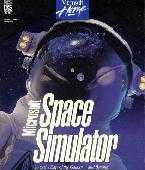Microsoft Space Simulator
| Microsoft Space Simulator | |
|---|---|
 | |
| Developer(s) | Bruce Artwick Organization Ltd. |
| Publisher(s) | Microsoft |
| Designer(s) | Charles Guy |
| Platform(s) | MS-DOS |
| Release date(s) | 1994 |
| Genre(s) | Simulation |
| Mode(s) | Single player |
| Distribution | 3.5" floppy disk, CD-ROM |
Microsoft Space Simulator is a space flight simulator program, based on Microsoft Flight Simulator for MS-DOS. It was one of the first general-purpose space flight simulators and it incorporated concepts from astrodynamics and celestial mechanics.
Features
- 14 spacecraft models ranging from a compact manned maneuvering unit (Shuttle's MMU) to an interplanetary passenger transport (Galactic Explorer) and a giant interstellar freighter (Zander Freighter),
- Destinations including space stations (both almost-historical e.g. Space Station Freedom and futuristic e.g. Ring Station 1), bases (e.g. Kennedy Space Center or futuristic Marineris Base on Mars) and celestial bodies (including comets) in both the solar system and outside (e.g. in the Polaris or Vega star system),
- Spacecraft instrument panel providing altitude and velocity information,
- Video recording and screenshots
- Predefined missions which task users with accomplishing certain objectives (like Apollo 17 moon landing or docking a Shuttle to Space Station Freedom),
- Autopilot and Flight computer autopilot can be used to execute 15 maneuvers of different complexities (ranging from attitude/orientation control to automatic landing). Maneuvers can be also compiled into a complete flight plan that can be automatically executed,
- Observatory mode that can be used as a planetarium for viewing stars and other celestial bodies
- Slew control mode
Physics engine
- Microsoft Space Simulator uses Newton's laws of motion but takes account of relativistic effects by decreasing a spacecraft's acceleration as its speed approaches the speed of light. It does not take account of time dilation.
- Atmospheric flight — atmosphere is not modeled
- Surface — all planetary surfaces are treated as flat spheres. No collision detection is implemented.
Genesis and evolution
Microsoft Space Simulator was released by Microsoft Home in 1994. It was developed by BAO Ltd. (the company run by Bruce Artwick who was also behind development of Microsoft Flight Simulator) with Charles Guy as lead developer. It was one of the last simulation games released for MS DOS.
It provided support for high-resolution graphics (at the time) running in 256 color mode on three resolutions: 320x400, 640x400, 800x600. The graphics featured dithered gouraud shading 3D vessels, with texture mapped planets, moons, and deep sky objects.
Sound
Microsoft Space Simulator features sound or music through an AdLib OPL2 card.
Included spacecraft
Spacecraft featured in the simulation are:
- Galactic Explorer
- Bussard Ramjet
- Callisto
- F-79 Galactic Fighter
- Zander Freighter
- All Terrain Lander (ATL)
- Space Shuttle
- Apollo Service Module
- Lunar Module (LM)
- Manned Maneuvering Unit (MMU)
Included Space Stations
Space stations featured on the simulation are:
- Ring Station 1 (Earth Orbit)
- Space Station Freedom (Low Earth Orbit)
- Lunar Orbiter (Moon Orbit)
- Mars Orbiter (Mars Orbit)
References
External links
- Microsoft Space Simulator at MobyGames
- Microsoft Space Simulator can be played for free in the browser at the Internet Archive
- MS Space Simulator Central Unofficial fan site
See also
- Orbiter — a freeware space flight simulator
- Celestia — free 3D astronomy program
- Stellarium — free planetarium program
- Buzz Aldrin's Race Into Space — a US-Soviet Space Race simulator
- Kerbal Space Program — an in-development Space flight simulator game